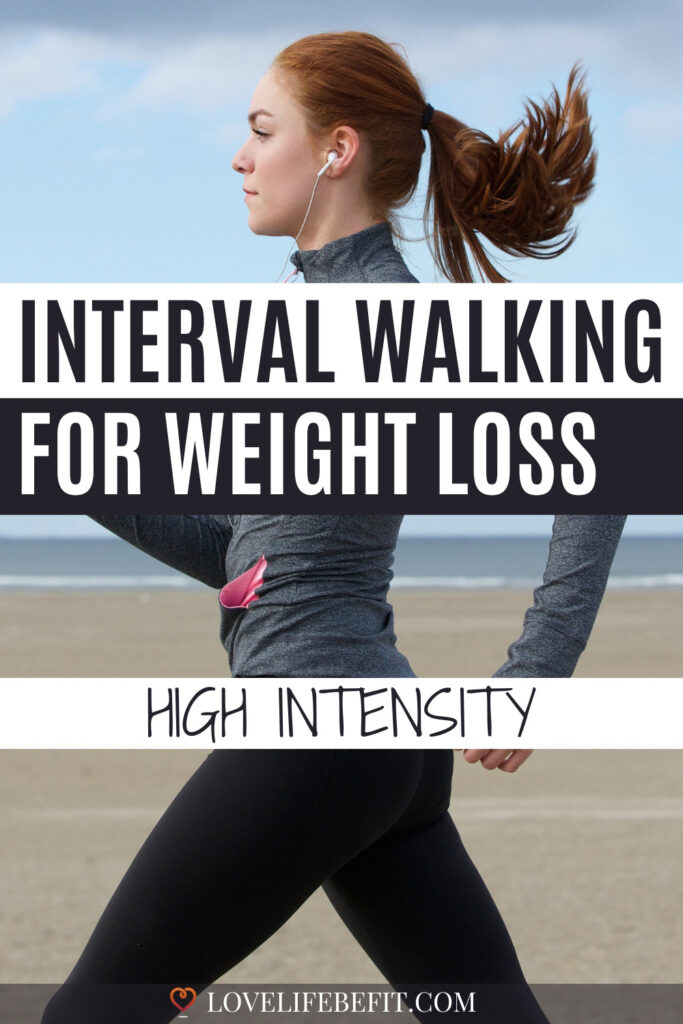Interval Walking For Weight Loss: Tips To Get Started
There isn’t a magic fix to weight loss but interval walking is as close as it gets. All the benefits of a high-intensity aerobic workout with the convenience of low-impact of walking.
Walking is one of my favorite ways to lose weight. It’s easy and accessible with so many health benefits. Just adding a 30-minute walk to your day improves your cardiovascular fitness, lowers blood pressure, and can help with mental health.
But, as your fitness level improves, it can take some extra intensity to lose those last few pounds and hit your target weight. That’s where interval walking workouts excel – vigorous exercise at high intensity for maximum calorie burn.

What Is Interval Walking?
Interval walking is alternating between fast and moderate-paced walking. The idea is to really push yourself and walk as fast as possible for a short period and then recover at a moderate or even easy walking pace.
Normally the intervals are timed – for example, 2 minutes of fast walking followed by 2 minutes of slower-paced walking.
How fast you walk will depend on your fitness level, but the goal is to find a pace that’s challenging such as power walking.
As you get fitter, the recovery intervals get shorter, the intensity of your workouts increases, and so does the calorie burn!
How To Start Interval Walking
Check-in with your doctor before starting a vigorous training program and make sure you have the right equipment. You’ll need comfortable walking shoes or trainers and an interval timer. You can use the stopwatch or walking app on your phone or a fitness tracker that’s able to time intervals.
- Warm-up: Start every interval session with a 5-minute warm. Begin at an easy pace and gradually increase your speed to a brisk walking pace.
- Fast Interval: Push yourself and walk as fast as possible. Pump your arms and quicken your pace. Your stride will be slightly shorter and you’ll be pushing hard as you roll off your back foot.
- Recovery Interval: Catch your breath and try to walk at a moderate or normal pace as you recover. Keep an eye on your stopwatch – the recovery period will pass quickly!
- Repeat the interval set: alternate fast and recovery intervals. This could be just 4 times or as much as 10 times. It depends on the length of the intervals and your fitness level.
- Cool-down: after you’ve finished the sets allow your heart rate to return to normal with a 5-minute easy walk.
Is It Better To Walk Continuously Or In Intervals?
When you’re a complete beginner, a walking routine of continuous effort is normally best. The aim is to walk regularly and that’s not going to happen if you wake up stiff and struggling to get out of bed from an overly ambitious walking workout.
Start with moderate walking at a steady pace and try out one of these challenges for beginners. When you’ve been walking continuously for 8 to 12 weeks, your legs will be stronger and ready to start interval walking.
Is Interval Walking Better For Weight Loss?
Walking in intervals is a great way to get fitter and increase your calorie burn. Interval walks are a great tool if you want to lose weight.
Interval training at high intensity can help with blood sugar control and you can burn more calories during a 30-minute workout than with a longer continuous walk.
Walking intervals make you work harder, increasing your heart rate and building strong leg muscles. The fast pace helps to boost your metabolism – you’ll continue to burn calories and body fat after your workout is over.

6 Interval Walking Workouts
Interval training isn’t something you should do every day. Add an interval walking workout to your exercise program no more than two or three times a week.
The aim for your fast intervals is to walk at a speed where it’s an effort to talk and breathing is labored. You’re aiming for a walking speed with a perceived exertion between 7-9 on the RPE chart.
Unless you’re a race walker, this may be hard to do without breaking into a jog or run. Some people use walk/run intervals as a way to start running.
Alternatively, you can make your sessions harder by adding hills, shortening the recovery period, or increasing the number of interval sets.
Here are some suggested workouts to start interval walking:
1. Beginner’s Interval Walking:
- Warm-up: 5 minutes moderate pace.
- Repeat the following set 4 – 6 times:
- 1-minute fast or power walking,
- 2 minutes recovery walking.
- Cool-down: 5 minutes easy pace.
2. Moderate Interval Walking:
- Warm-up: 5 minutes moderate pace.
- Repeat the following set 6-8 times:
- 2 minutes fast or power walking,
- 1-minute recovery walking.
- Cool-down: 5 minutes easy pace.
3. Challenging Interval Walking:
- Warm-up: 5 minutes moderate pace.
- Repeat the following set 6-8 times:
- 3 minutes fast or power walking,
- 1-minute recovery walking.
- Cool-down: 5 minutes easy pace.
4. Hill Interval Walking:
- Warm-up: 5 minutes moderate pace on flat terrain.
- Repeat the following set 5 times:
- 2 minutes brisk pace walking uphill,
- 2 minutes recovery walking downhill.
- Cool-down: 5 minutes easy pace on flat terrain.
5. Pyramid Interval Walking Workout:
- Warm-up: 5 minutes moderate pace.
- 1-minute fast walking, 1-minute recovery walking.
- 2 minutes fast walking, 1-minute recovery walking.
- 3 minutes fast walking, 1-minute recovery walking.
- 2 minutes fast walking, 1-minute recovery walking.
- 1-minute fast walking, 1-minute recovery walking.
- Cool-down: 5 minutes easy pace.
6. Progressive Interval Walking Workout:
- Warm-up: 5 minutes moderate pace.
- 1-minute fast walking, 4 minutes recovery walking.
- 2 minutes fast walking, 3 minutes recovery walking.
- 3 minutes fast walking, 2 minutes recovery walking.
- 4 minutes fast walking, 1-minute recovery walking.
- Cool-down: 5 minutes easy pace.
Modify these workouts to fit your personal fitness level and goals. Always listen to your body and adjust the intensity as needed. As you progress and become more comfortable with interval walking, challenge yourself by increasing the duration or intensity of the fast intervals or reducing the recovery time.

Thoughts From Love Life Be Fit
High-intensity intervals can be a great boost to your fitness routine, increasing your calorie burn and helping you hit your weight loss goals. But intervals are not suitable for everyone. Pushing too hard too soon in your workouts can lead to injury. It’s better to build your leg strength first with continuous walking before adding intervals to your exercise routine.
As you get fitter, it can be hard to increase exercise intensity purely by walking faster. You may want to try walk-run intervals or add in incline or hill training.
Intervals can be a good way to add variety and keep your training interesting. Other ways to make walking more fun include walking with friends, exploring new routes, and getting into nature.





